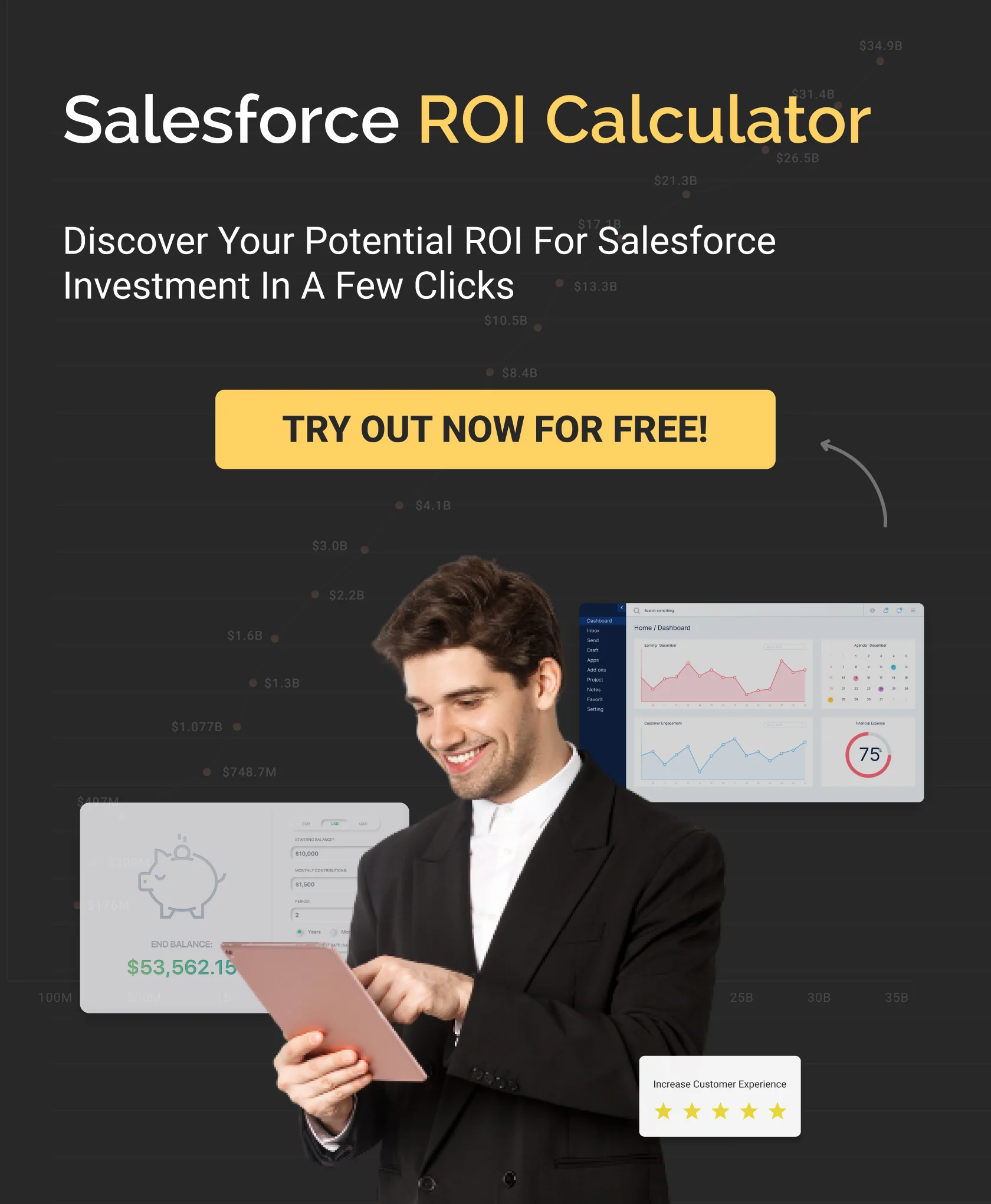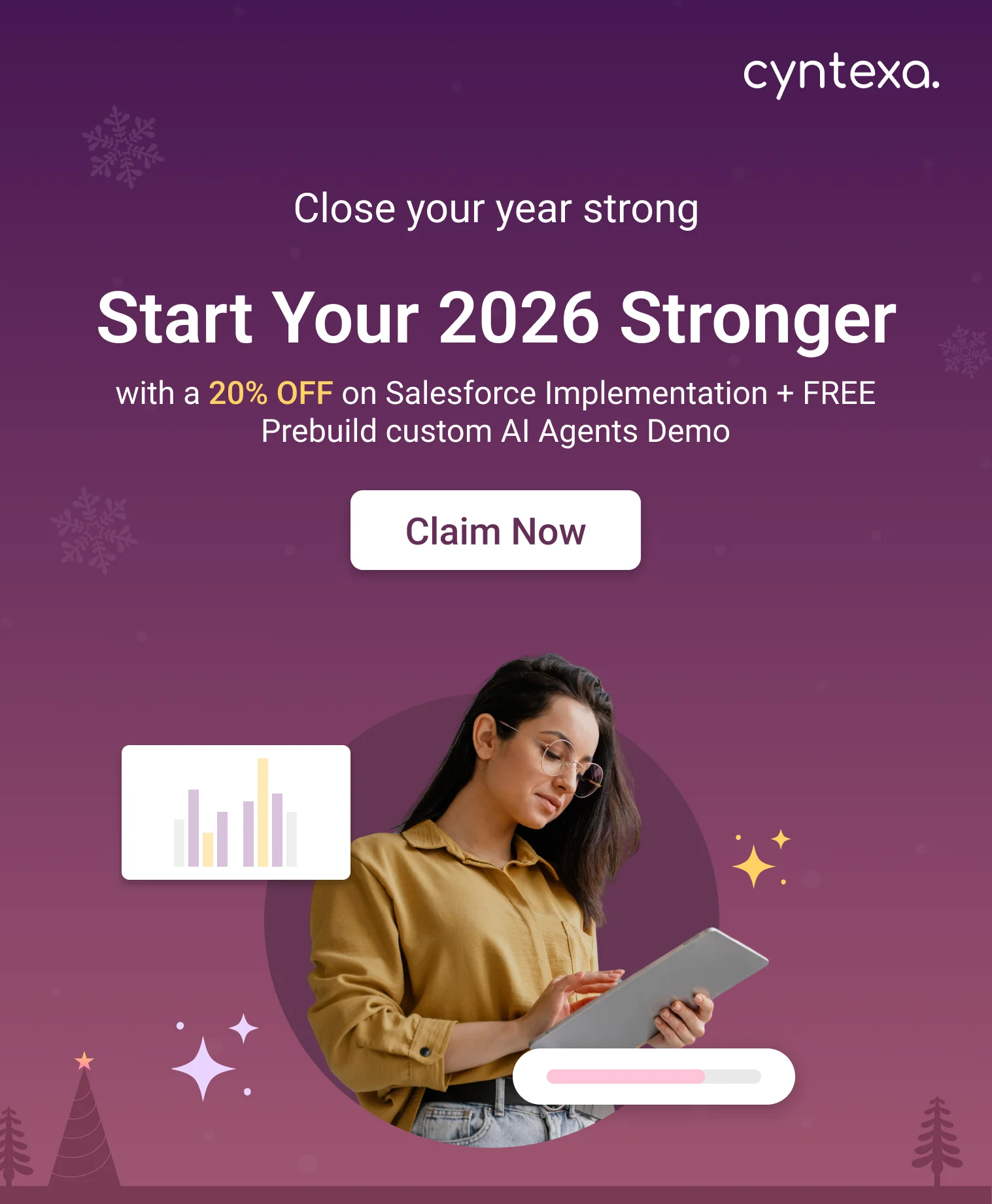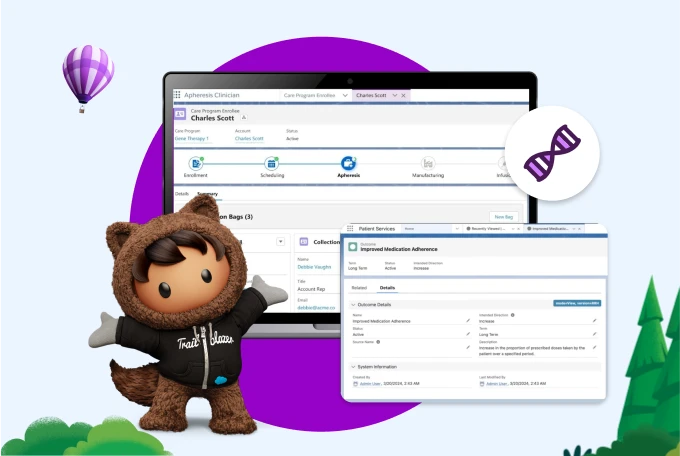What Is Salesforce Life Sciences Cloud? A Complete Overview
Table of Contents
Blog Summary
- Salesforce Life Sciences Cloud is a unified CRM platform built specifically for pharmaceutical, biotech, and medtech companies, eliminating the need for multiple, disconnected software tools.
- It unifies data and processes across clinical trials, patient engagement, and commercial operations, all on one secure platform.
- Core capabilities include AI-driven automation (Agentforce), end-to-end clinical trial management (participant recruitment, site management), and ensuring safety compliance.
- Designed around purpose-built data models for healthcare, ensuring data standardization and regulatory adherence (e.g., HIPAA, FDA).
- For patient services, it streamlines insurance verification, offers personalized support, and tracks patient outcomes in real-time.
- Salesforce Life Science Cloud pricing starts at $325/user/month, with top plans including advanced AI features and more data capacity.
Salesforce Life Sciences Cloud (LSC) is a purpose-built platform designed especially for businesses in the life sciences industry, including pharmaceutical (pharma), biotechnology (biotech), and medical technology (medtech) organizations.
You do not need different applications for managing patient and healthcare professional enrollment processes, clinical trials, patient services, finances, and more. This platform is a unified solution for all your clinical, medical, and commercial needs.
Suppose you are a biotech company involved in creating a new medicine. You may require different software for various functions: one to manage clinical trials, another to track patients and support them, a different tool to handle financial records, and yet another to manage your sales and marketing efforts.
The data stored would be siloed and duplicated across all platforms. Hence, by leveraging Salesforce Life Sciences Cloud, you can bring everything in one place. This eliminates switching between different platforms and data silos issues and keeps everything connected, secure and efficient.
Catering to a similar industry, Salesforce offers the Health Cloud, which is primarily designed to address the needs of individuals, including healthcare professionals, payers, and patients. While Life Sciences Cloud covers a broader aspect by focusing on industry-specific organizational needs.
After the Veeva and Salesforce split, Life Sciences Cloud is backed up with versatile functionalities such as Agentforce autonomous agents, seamless HPC management, and much more. Read this blog to uncover the intricacies of Salesforce Life Sciences Cloud.
Let’s get started!
Features and Benefits of Salesforce Life Sciences Cloud
Here are the key feature offerings based on categorization:
1. Agentforce for Life Sciences Cloud
Agentforce brings AI, data, reasoning, and actionable capabilities altogether, focusing on the life sciences industry’s needs. It automates routine tasks across clinical, medical, and commercial workflows, which cuts manual efforts
- It relies on Data Cloud to unify structured and unstructured patient or HCP data for real-time context.
- With the Einstein Trust Layer, agents ensure compliance by masking sensitive data, performing checks and audit trails, and maintaining HIPAA and other regulatory standards.
- Agentforce’s Agent Builder allows for low-code life sciences-specific configuration of agents such as ‘patient enrollment,’ ‘HCP outreach,’ and more.
Having these capabilities, Salesforce Life Sciences Cloud is known as an ‘end-to-end agentic AI customer experience platform’ that brings sales, service, marketing, and clinical data of a business together.
2. Clinical features
Participant and Recruitment Management
Participants here include pharma companies, biotech firms, medical device manufacturers, consumer health companies, and more.
Salesforce LSC helps you digitize and optimize the entire recruitment journey from the initial contact to enrollment and beyond. Through AI-powered auto-matching and predictive analytics, you can quickly identify and engage the right candidates, regardless of any participant category. Moreover, with AI assistance, you can get suggestions to recruit optimal, diverse candidate groups while identifying the best trial locations.
Personalized dashboards give you real-time visibility into each participant’s status in the onboarding pipeline, while advanced blinding techniques keep your studies unbiased. Together, these tools speed up recruitment, improve the candidate vetting quality, and strengthen trust between sponsors and volunteers. The result is smoother, more efficient trials with faster enrollments and fewer dropouts.
Site and Sponsor Management
Salesforce Life Sciences Cloud brings site and sponsor management together. It helps you identify, assess, and manage research sites where the clinical trials are being conducted. Through this platform, you can track and manage workflows while also overseeing the progress and planning study close-outs with ease.
It standardizes your operations and ensures study readiness and compliance across global clinical sites while mitigating operational risks.
Safety and compliance
Salesforce LSC’s chain of custody capability automatically records a traceable history of events, allowing easy past lookup.
The built-in e-signature tracking guides your team through every required approval and step while reducing manual work.
All the activities flow into FDA-aligned audit tools, offering real-time visibility into compliance metrics and governance checkpoints. It keeps regulators satisfied and minimizes your liability.
3. Medical features
Medical Affairs and Inquiry Management
It helps businesses manage medical interactions and streamline inquiries from healthcare professionals and other stakeholders.
With the AI capabilities in the platform and integration with Salesforce Data Cloud, medical teams can create personalized, accurate, and scientifically sound responses and suggestions.
The built-in audit log tracking maintains compliance and captures every interaction, while human-in-loop workflows keep expert oversight, maintaining authority and precision that builds trust among HCPs.
HCP Management
It manages how well and how often pharma, medtech, and biotech companies interact with healthcare professionals, complying with marketing and sales efforts.
It leverages AI-powered next-best-action workflows to guide reps on what to do next. Whether it’s sending a follow-up email, scheduling a visit, or recommending the right samples, these interactions become relevant and personalized, increasing positive engagement.
Through omnichannel outreach, covering everything from in-person visits to digital touchpoints, businesses consistently stay connected with HCPs.
4. Patient Services
Insurance Verification
Verifying insurance is a crucial yet time-consuming process when done manually. But Salesforce Life Sciences Cloud streamlines it through AI and automation capabilities.
It offers automated tools for verifying and re-verifying pharmacy benefits, ensuring the coverage details are up-to-date and accurate. The real-time alert feature notifies care coordinators when there is a change in insurance status.
You can gain a real-time view into the verification pipeline through personalized dashboards. This overall helps your business teams focus less on paperwork and more on supporting better health outcomes.
Personalized Support and Financial Assistance
Salesforce Life Sciences Cloud empowers your teams to deliver personalized support by guiding patients through their therapy journey. With features like co-pay assistance, i.e., the fixed amount a patient pays for covered healthcare services, and next-best-action workflows, you can proactively address common patient-related issues. Be these issues are financial or operational, that delay or disrupt treatment. This consistent and compliant care experience increases patient satisfaction.
Outcomes Tracking and Safety Monitoring
Salesforce LSC can capture patient-reported outcomes and adverse events in real-time. It keeps you in sync with what patients are experiencing during and after treatment. It uses a FHIR-aligned data model, which standardizes how health data is collected, shared, and understood across systems. Therefore, the patient feedback and safety signals are quick, structured, and interoperable, enabling quicker responses and better insights.
By continuously monitoring outcomes and safety, you can detect patterns, identify risks early, get automated and proactive alerts, and improve overall patient care.
5. Commercial Services
Intelligent Sales and Visit Management
You get everything you need to execute high-impact field management. LSC offers structured visit management workflows to field reps, from planning and scheduling to executing and follow-up. These workflows are integrated with CRM activity feeds, tasks, opportunity updates, and product catalog insights. With this, reps can better prioritize their time, focus on the right accounts, and deliver personalized conversations. By leveraging AI assistants, they can prepare for HCP visits and follow-ups.
This coordination eliminates guesswork, strengthens account coverage, and ensures that valuable interactions translate into meaningful impact for both the business and healthcare professionals.
Field Inventory Management
Salesforce Life Sciences Cloud offers real-time tracking capabilities for smarter inventory control in the field. As sales reps engage with healthcare professionals (HCPs), the system keeps tabs on available medical devices and drug samples. It automatically syncs inventory data with every interaction, avoiding stock-outs during critical HCP meetings.
AI-driven alerts notify teams when stock levels run low. They can perform timely replenishment, which reduces the risk of missed opportunities. It lets representatives focus on meaningful engagement rather than operational hassles.
Rebate Management
Rebate Management helps you take control of complex commercial agreements. It automates the creation, execution, and tracking of rebate programs, and every deal is transparent.
The automation not only reduces administrative overhead but also helps you stay competitive with more dynamic and responsive pricing strategies. Whether negotiating volume-based incentives or performance-linked rebates, you can configure terms, monitor compliance, and process claims with ease.
The result is improved financial forecasting, and the rebate agreements are aligned with both regulatory standards and internal policies.
Account Profitability and Asset Tracking
You can easily keep track of how your products are performing and how your assets are being used in the field. With built-in asset management modules, you can monitor product usage and gather feedback directly from healthcare providers and customers. You get real-time visibility into asset location, its condition, and utilization, helping you make smarter decisions as to when to renew, redeploy, or retire assets.
By combining asset data with account performance, you can gain a clearer picture of their return on investment (ROI) from product deployments. This insight helps sales and operations teams identify which accounts are driving the most value and where adjustments are needed to improve profitability.
All this supports proactive planning for future inventory, service requirements, and customer engagements, turning operational data into a strategic advantage.


Salesforce Life Sciences Cloud Data Models
Here, we have explained various data models leveraged by the Life Sciences Cloud. These models explain the data structure and operational working.
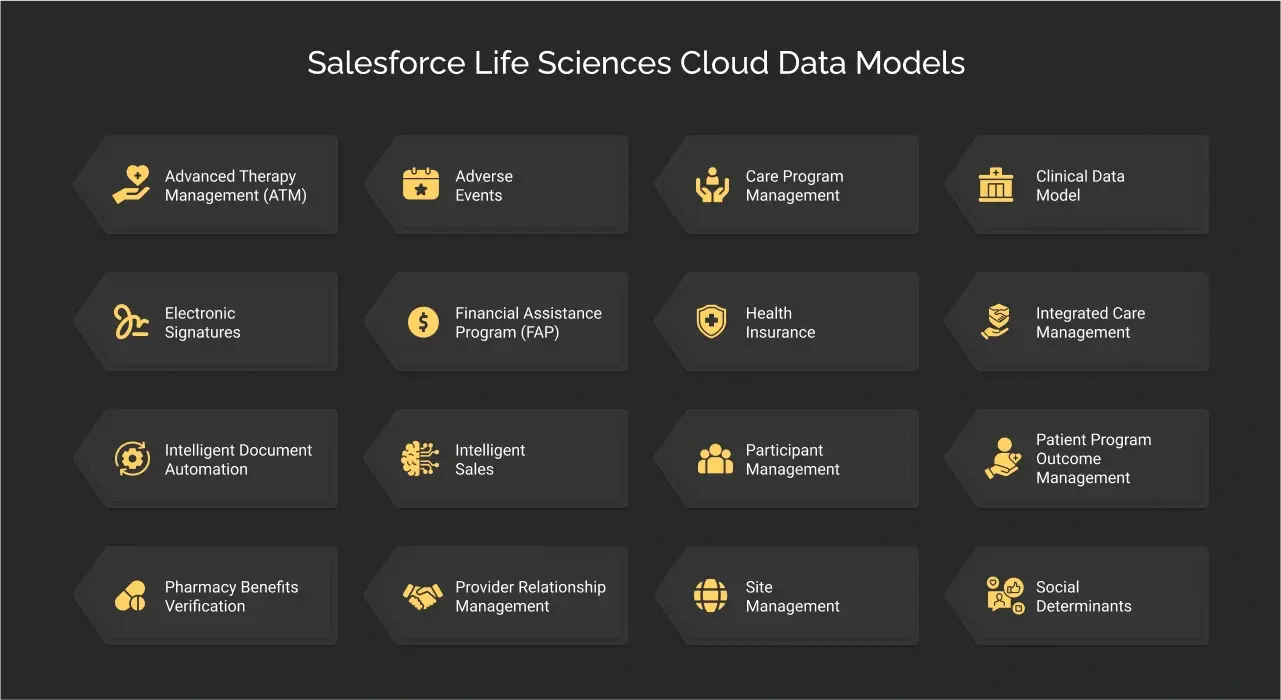
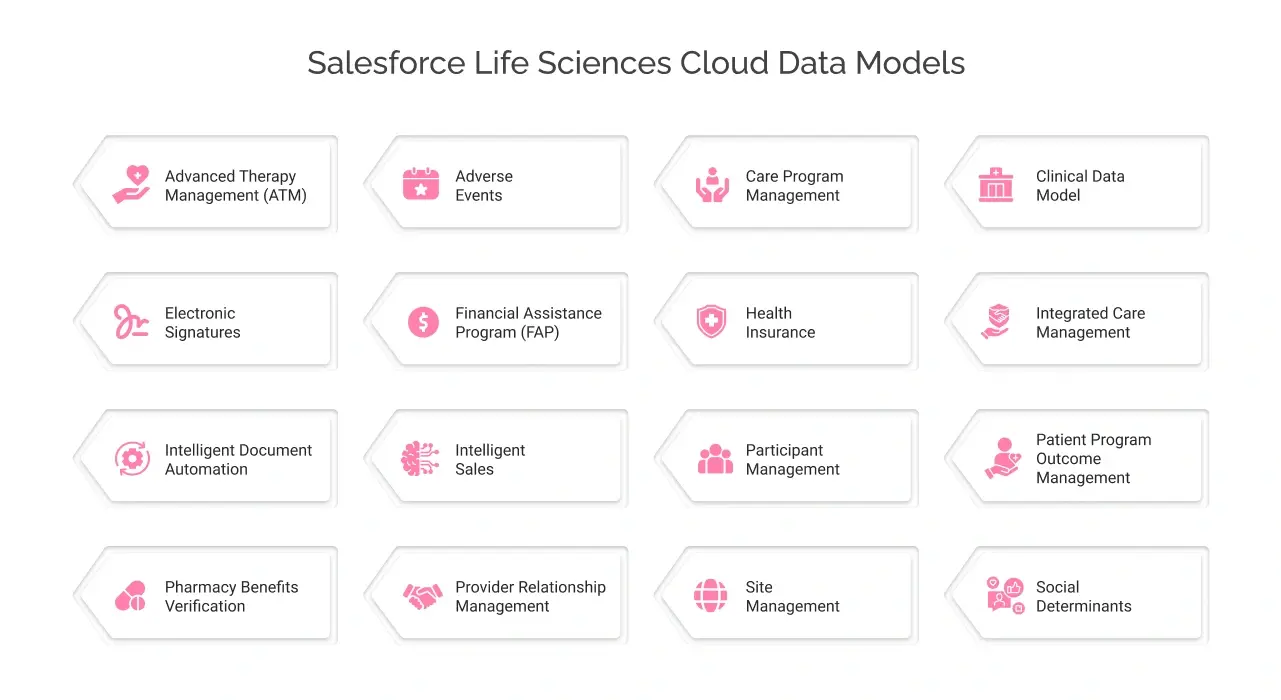
1. Advanced Therapy Management (ATM)
A set of objects for scheduling and tracking multi-step treatments and procedures like cell or gene therapies across different sites. It keeps all appointment steps, locations, and ownership in a single place so coordinators can book, reschedule, or cancel at a glance. It avoids mix-ups in complex therapy flows.
Some of the objects are:
- AdvTherapyFieldOptOverride: Represents a list of fields with changed optionality.
- CareProgramEnrollee: Participant enrolled in a care program
- CustodyItem: Information about an item in a custody chain.
- Team: Represents a group of people.
- TeamMember: Represents an individual of a team, and more.
2. Adverse Events
It logs any unfavorable effects or symptoms that the participants experience during a research study. These symptoms could be anything from a small discomfort to a serious health issue. Therefore, this data model centralizes safety data so you can spot trends, meet regulatory requirements, and trigger follow-up actions quickly.
Some of the objects are:
- AdverseEventAction: Represents preventive actions that prevent an adverse event.
- AdverseEventContribFactor: Represents the contributing factor to an adverse event.
- AdverseEventOutcome: Outcome of the adverse event.
- AdverseEventParty: Shows who participated in the adverse event.
- There are other objects as well.
3. Care Program Management
A model for enrolling people into ongoing care programs, such as chronic-disease support, and tracking their progress. This way, you get insight into the real-time data, and it drives better adherence by managing reminders, check-ins, and milestones in a unified framework.
Some of the objects are:
- CareProgram: Represents a set of activities of a care program.
- CareProgramEligibilityRule: Defines the eligibility rule of a care program, as to who can enroll in it.
- CareProgramEnrollee: Represents a participant enrolled in a care program, and many more.
4. Clinical Data Model
It stores patient and clinical trial data, such as observations, conditions, etc., in a structured form while aligning to FHIR and USCDI standards.
FHIR (Fast Healthcare Interoperability Resources) and USCDI (United States Core Data for Interoperability) are health data standards that define how healthcare information is exchanged and accessed between different systems.
This model ensures your Salesforce Org uses the same data language as hospitals and EMRs do, making data exchange seamless and reducing errors.
- Some of the objects are as follows:
- ActivityTiming: Tells detailed information about an activity that takes place in regular intervals.
- AuthorNote: It stores different notes created by an author, with details such as name and time of creation.
- ClinicalDetectedIssue: Tells about an issue detected in a clinical activity.
- And more.
5. Electronic Signatures
It captures who signed what and when, in what order, and with what permissions. It automates audit trails for any e-sign process, be it consents or approvals, so you stay compliant, eliminating any manual paperwork.
Some of the objects are as follows:
- DigitalVerification: It stores information about the verification of a record.
- DigitalVerificationSetup: Stores information about a digital verification setup.
- DigitalVerfSetupDetail: It stores contextual details of a digital verification setup, such as the user who does the verification and the messages that display at the time of verification.
6. Financial Assistance Program (FAP)
This model helps businesses create financial assistance programs for patients by tracking eligibility and recording disbursements. It makes it easy to see who qualifies for support, how much they’ve received, and when to renew, reducing out-of-pocket barriers.
Some of the objects are:
- Applicant: Represents the person enrolled in the program.
- BenefitType: Shows the type of benefit.
- ProgramEnrollment: Incorporates the details of enrollment.
7. Health Insurance
It is a data structure for capturing coverage details such as plans, benefits, dependents, and pre-authorizations. It helps care teams verify eligibility, manage claims, and coordinate benefits all in one place, without switching between multiple systems.
Some of the objects are:
- CarePreauth: Shows the details of preauthorizations for care under a member’s plan.
- Member: Represents the primary subscriber.
- Payer: It represents the health insurance company that pays the cost, and there are many other objects.
8. Integrated Care Management
It stores clinical data that is FHIR R4 aligned and related to the patient’s and member’s care plan. This model combines medical, social, and administrative data into one care-plan view, enabling holistic and coordinated patient management.
The objects:
- CarePlan: Represents a care plan.
- CarePlanTemplate: Represents the template for the care plan.
- GoalAssignment: Showcases the goal of the care plan.
9. Intelligent Document Automation
This model helps manage clinical and medical forms and documents. It reduces the need for manual data entry by automatically processing and routing documents. This allows staff to focus more on patient care and less on paperwork.
Objects that this data model covers:
- ReceivedDocument: It contains a request for an operation to be performed on a document, such as rotating, splitting, or text extraction.
- ReceivedDocumentType: Represents a junction object between the received document and document type.
10. Intelligent Sales
This data model helps in planning and executing sales visits, tracking samples/inventory, and logging field activities. It gives commercial reps a single source of truth for call planning, product demos, and follow-up.
Objects of this data model:
- Address: Represents a mailing, billing, or home address.
- Visitor: It represents the sales reps performing visits.
- Pricebook: It contains the list of products you sell in your Org.
- Product: Represents the product you sell.
- And many more.
11. Participant Management
We have already discussed above, this data model makes it possible to manage participants by streamlining the recruitment and enrollment processes. It centralizes participant profiles so recruiters and coordinators always work with the latest information.
The objects in it are as follows:
- DiagnosticSummary: It represents the findings, interpretations, and summaries of patient tests.
- DigitalVerification: It stores information about the verification of a digital record.
- ResearchStudy: Represents details of a research study.
12. Patient Program Outcome Management
This model is used for defining desired outcomes, linking patient progress to those goals, and summarizing results. It measures program success objectively, so you can report on impact and optimize care pathways.
The data objects are as follows:
- Outcome: Shows information about the expected change in participants due to organizational activity.
- TimePeriod: Shows the time period that is used to calculate indicator performance and the result.
- IndicatorAssignment: An indicator is a measurable characteristic that tracks the progress and success of a patient program. Therefore, this object represents its assignment.
- There are other objects as well.
13. Pharmacy Benefits Verification
It includes FHIR-CARIN and NCPDP-aligned objects to check prescription benefit coverage. This model integrates real-time benefit checks into your workflow, so patients know their copay and coverage before they get to the pharmacy.
The objects are as follows:
- AssessmentEnvelope: It represents information about an envelope that contains the assessments related to a user.
- AssessmentEnvelopeItem: Represents an item in the envelope.
- CareBenefitVerifyRequest: It is the request for verifying the benefits.
14. Provider Relationship Management
This leverages standard Account and Contact records along with specific fields for partners to show the relationships and connections of healthcare professionals. It enables segmented engagement on the basis of specialty, region, and affiliation. This strengthens your targeting and reporting capabilities.
The objects in it are as follows:
- BoardCertification: Represents the practitioner’s board certifications and specialty in a particular field.
- BusinessLicense: Represents the licenses of a party.
- CareService: It represents a healthcare service, treatment, or procedure offered by a provider, practitioner, or facility.
15. Site Management
It includes objects to capture research-site details, investigator scores, and selection criteria. This model helps in site selection by scoring responses, tagging favorites, and maintaining a searchable site/investigator directory.
Some of the objects are:
- CareProgramSiteContract: It represents the connection of a care program site and a contract.
- CareSiteIstgrSearchableFld: This represents information about the clinical trial investigator associated with a site.
- PartyPublication: It represents the details of a party’s publication.
16. Social Determinants
This model represents the barriers and interventions, such as housing, food insecurity, etc., that might affect patient outcomes. It lets care teams record and address social needs in the same system. This results in building more comprehensive and personalized care plans.
Some of the objects are as follows:
- CareBarrier: It represents the circumstances or obstacles affecting a patient or member.
- CareBarrierType: Represents the type of barrier.
- CareDeterminant: It represents the determinants of health of a patient. These could be safe housing, adequate employment, or local food markets.
17. Timeline
It is a configuration layer for combining records such as visits, events, updates, etc., into a chronological feed. This offers a single, date-ordered view of everything that’s happened for a person or program, improving situational awareness at a glance.
It includes the following objects:
- TimelineObjectDefinitionLocalization: This shows the translated value of a timeline configuration’s main label when your organization uses the Translation Workbench.


How to Setup Salesforce Life Sciences Cloud
Here is a stepwise procedure to leverage LSC in your business:
Step 1: Click on this link.
Step 2: Click on Try for free.
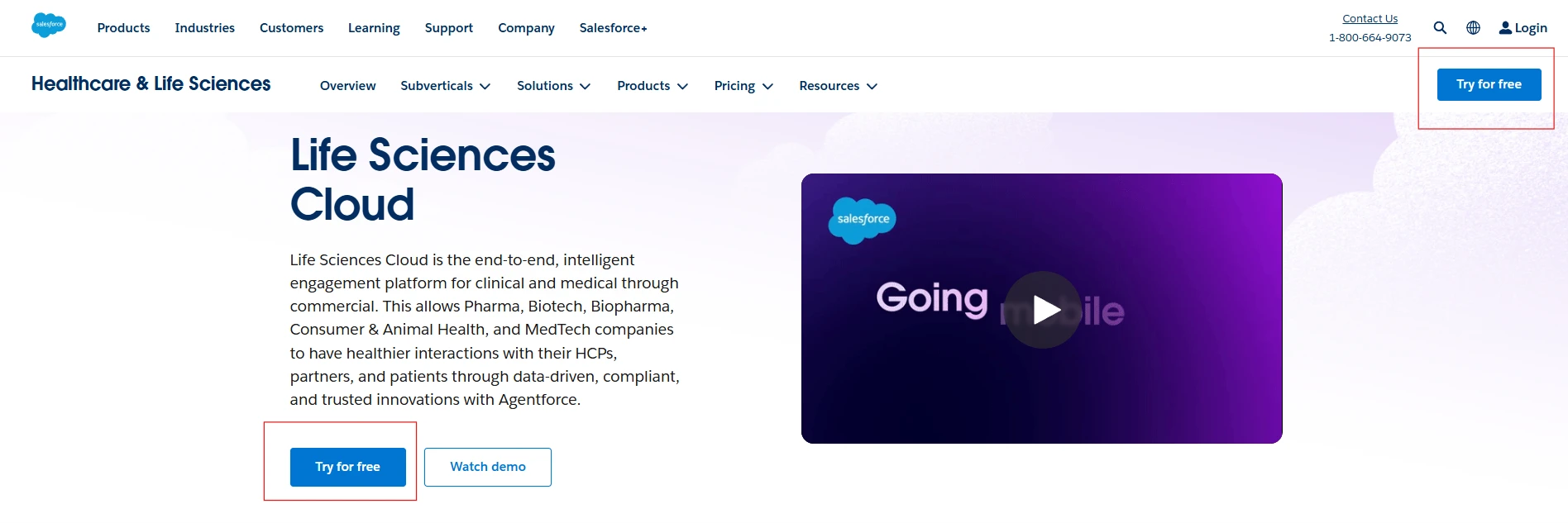
Step 3: Enter all your details and submit the form.
You will receive an email with your username and password setup link.
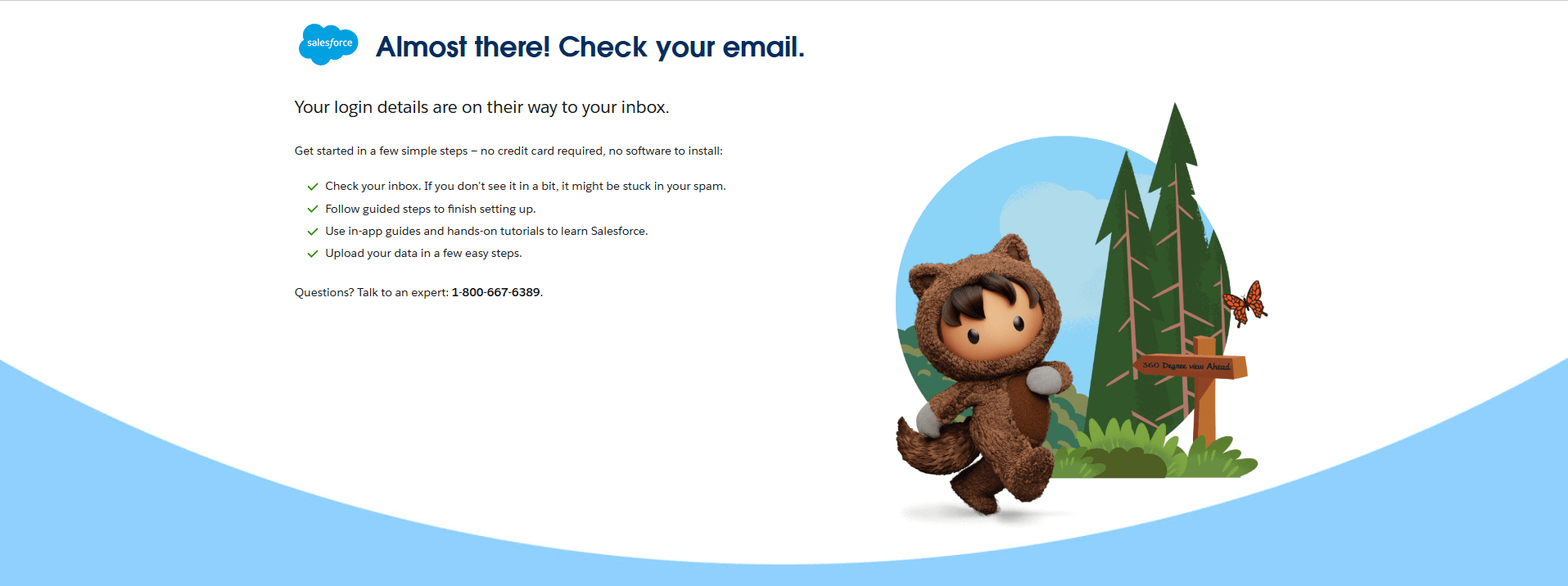
Step 4: Set up your password and log in to the Org through your credentials.
This is how your Salesforce Life Sciences Cloud Org looks:

Step 5: Customize the Org as per your business needs and get started with the cloud.


Salesforce Life Science Cloud Pricing
The cloud offers distinct pricing options that we have discussed below. Go through them to select the best plan for your business:
| Basis/Name | Enterprise Plan | Unlimited Plan | Agentforce 1 for Service Plan | Agentforce 1 for Sales Plan |
|---|---|---|---|---|
| Pricing (per user, per month) | $325 | $500 | $750 | $750 |
| Features | Offers all the clinical, medical, field inventory management, commercial, and patient services features. You need to purchase the Agentforce plan additionally. | Everything from Enterprise Edition + more storage and automation features. 24/7 Toll-free Support and Expert Coaching. You need to purchase the Agentforce plan additionally. | Everything from the Unlimited edition. You get access to Agentforce capabilities and service automations, and features. | Everything from the Unlimited edition. You get access to Agentforce capabilities and sales automation features. |
| Participant recruitment and enrollment | $10,000/org/year, increments of 100 patients referred | (Create a tick mark in the middle of the table.) | Create a tick mark in the middle of the table.) | (Create a tick mark in the middle of the table.) |
| Data Cloud availability | 250K credits/org/year | 250K credits/org/year | Offers 2.5 million credits/org/year & 1 TB of storage, 20 GB of storage per user | Offers 2.5 million credits/org/year & 1 TB of storage, 20 GB of storage per user |
| Sales and service features. | Need to purchase sales and services features. | Need to purchase sales and services features. | Salesforce Service features are available, but not Sales. | Salesforce Sales features are available, but no Services. |
| Einstein’s next best action | 5000 requests per Org per month. | (Create a tick mark in the middle of the table.) | Create a tick mark in the middle of the table.) | (Create a tick mark in the middle of the table.) |
Conclusion
Salesforce Life Sciences Cloud is designed to support the needs of the life sciences industry. It offers unified data models, AI-driven features, and purpose-built tools for commercial, clinical, compliance, and patient engagement.
As the industry evolves, this cloud solution continues to grow and become more powerful, and future-ready capabilities enhance speed, personalization, and trust at every stage.
Salesforce Life Sciences Cloud is trusted by more than 70 business leaders, including Boehringer Ingelheim, Fresenius Kabi, Penumbra, Pfizer, Protas, and Takeda. Therefore, showcasing a strong market validation and adoption across pharmaceutical, medical technology, and contract research organizations (CROs).
Want to grasp the best of Life Sciences Cloud in your business? Connect with Cyntexa to gain expert Salesforce consulting services. Our team will help you tailor its implementation as per your unique business needs. We ensure that your digital transformation is aligned with regulatory needs and business goals.
Don’t Worry, We Got You Covered!
Get The Expert curated eGuide straight to your inbox and get going with the Salesforce Excellence.
AUTHOR
Tanushri
Head of Growth And Strategy
Tanushri heads Growth and Strategy at Cyntexa, with over 6 years of experience in sales and marketing. She specializes in aligning go-to-market teams, scaling revenue operations, and building structured, tech-enabled growth plans. Tanushri also advises businesses on Salesforce, ServiceNow, AWS and Google Cloud adoption, ensuring each strategy is execution-ready, future-proof, and tailored to the organization’s maturity and growth goals.


Cyntexa.
Join Our Newsletter. Get Your Daily Dose Of Search Know-How
Frequently Asked Questions
Health Cloud is especially designed for healthcare providers such as hospitals and clinics. It focuses on patient care coordination, telehealth, referrals, and treatment plan activities. Whereas Salesforce LSC focuses on the overall needs of the life sciences businesses, such as medtech, pharma, and biotech. It offers versatile features to manage the clinical trials, regulatory compliance and interaction with healthcare professionals.
- Hence, Health Cloud is more patient-focused, and Salesforce LSC is more product- and trial-focused.
Yes, LSC can be integrated with Health Cloud, as both clouds are built on the Salesforce platform, allowing native integration. You can use the combined capabilities of both clouds.
Salesforce LSC is built on Salesforce, and it is highly customizable as per the unique needs of businesses. It is backed by the Salesforce ecosystem, including versatile AI capabilities and its other products; therefore, there is no need to re-platform. It offers robust predictive analytics and Data Cloud integration. Whereas, Veeva has re-platformed to its foundation platform called the Vault platform. It is pre-configured for life sciences and is less customizable. It has Veeva clinical, regulatory, and content tools, yet limited analytics capability.
